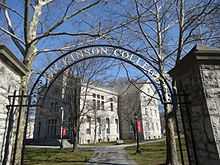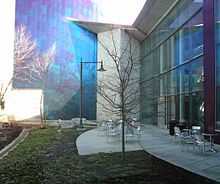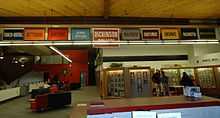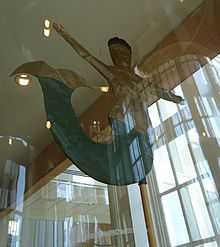Dickinson College
| Dickinson College | |
|---|---|
 | |
| Motto | Latin: Pietate et doctrina tuta libertas |
| Motto in English | Freedom is made safe through character and learning |
| Established | 1773 |
| Type | Private liberal arts college |
| Endowment | $388.6 million[1] |
| President | Nancy A. Roseman |
| Academic staff | 245 |
| Undergraduates | 2,384 |
| Location | Carlisle, PA, USA |
| Campus |
Suburban 170 acres (69 ha) |
| Colors | Red and White |
| Nickname | Red Devils |
| Website | http://www.dickinson.edu/ |
Dickinson College is a private residential liberal arts college in Carlisle, Pennsylvania, United States.[2] Originally established as a grammar school in 1773, Dickinson was chartered September 9, 1783, six days after the signing of the Treaty of Paris, making it the first college to be founded in the newly recognized United States. Dickinson was founded by Benjamin Rush, a signer of the United States Declaration of Independence and originally named "John and Mary's College" in honor of a signer of the Constitution, John Dickinson, who was later the President of Pennsylvania and his wife, Mary Norris Dickinson, who donated much of her extensive personal library, combined with John Dickinson's library, to the school.[3] Dickinson College is America's 16th oldest college.
With over 240 full-time faculty members and an enrollment of nearly 2,400 students, Dickinson is known for its innovative curriculum and international education programs. Dickinson sponsors 12 study centers in other countries and its approach to global education has received national recognition from the American Council on Education and NAFSA: Association of International Educators.[4][5] The college was among six institutions profiled in depth by NAFSA for "Outstanding Campus Internationalization" in 2003 [6] Each year, Dickinson receives approximately 6,000 applications for its 600 spaces — putting it among the top liberal arts colleges in the nation. In 2013 Dickinson's endowment stood at $388 million — it is estimated it will top $400 million in early 2014.
Dickinson College is not to be confused with the Dickinson School of Law, which abuts the campus but is no longer affiliated with the college.
History
The Carlisle Grammar School was founded in 1773 as a frontier Latin school for the young men in western Pennsylvania. Within years Carlisle's elite, especially James Wilson and John Montgomery, were pushing for an expansion of the school into a college. In 1782 Benjamin Rush, a revolutionary leader and the preeminent physician in the new nation, met in Philadelphia with Montgomery on the porch of prominent businessman and politician William Bingham to discuss the founding of a frontier college in the town. It was in this conversation that the idea for the college was formed, and "Bingham's Porch" was long a rallying cry at Dickinson.
Dickinson College was chartered by the Pennsylvania legislature on September 9, 1783, six days after the signing of the Treaty of Paris (1783) ending the American Revolution, making it the first college founded in the newly recognized nation. Rush intended to name the institution after the President of Pennsylvania John Dickinson and his wife Mary Norris Dickinson, originally calling it "John and Mary's College." John and Mary Norris Dickinson had given the new university an extensive library they jointly owned, one of the largest libraries in the colonies.[7][8] The name Dickinson College was chosen instead. At the time of its founding its location west of the Susquehanna River made it the westernmost college in America. For the first meeting of the trustees, held in April 1784, Rush made his first journey to Carlisle. The trustees selected Dr. Charles Nisbet D.D. a Scottish minister and scholar, to serve as the College's first president. He arrived and began to serve on July 4, 1785 and served faithfully until his unexpected death in 1804.[9]

A combination of financial troubles and faculty dissension led to a college closing from 1816-1821. In 1832, when the trustees were unable to resolve a faculty curriculum dispute, they ordered Dickinson's temporary closure a second time.[10]
The law school dates back to 1833, and became a separate school within Dickinson in 1890. The Law School separated from Dickinson in 1919. It is now affiliated with Penn State.[10]
Among the 18th century graduates of Dickinson were two U.S. Supreme Court justices, Robert Cooper Grier and Roger Brooke Taney, who served together on the Court for 18 years.

During the 19th century two famous Dickinson College alumni were important participants in issues which led to the Civil War. These were James Buchanan, the 15th President of the United States, and Roger Brooke Taney, Chief Justice of the United States. It was under Taney's leadership that the Supreme Court issued the Dred Scott v. Sandford decision, which held that Congress could not prohibit slavery in federal territories. Buchanan threw the full prestige of his administration behind congressional approval of the Lecompton Constitution in Kansas. The campus and the town of Carlisle were twice occupied by Confederate forces in 1863.[11]
When George Metzger, class of 1798, died in 1879 he left his land and $25,000 to the town of Carlisle for the purpose of opening a college for women. In 1881, the Metzger Institute, a College for Young Ladies, opened. The college existed separately until 1913, when its building was leased to Dickinson College for the education of women, and the building served as a women's dorm until 1963.[12]
Henry Clarke, alumnus who developed the Klondike bar into a national brand, founded the Clarke Forum for Contemporary Issues at Dickinson College.[13]
Carlisle was also home to the Carlisle Indian Industrial School, less than two miles from the campus. Dickinson College and the Carlisle Indian School collaboration began when Dr. James McCauley, President of Dickinson College, led the first worship service at the Indian School in 1879. The collaborative effort between Dickinson College and the Carlisle Indian School lasted almost four decades, from the opening day to the closing of the school in 1918. Dickinson College professors served as chaplains and special faculty to the to the Indian School,[14] and college students volunteered services, observed teaching methods and participated in events.[15] Dickinson College also provided Carlisle Indian School students with access to the Dickinson Preparatory School ("Conway Hall") and college level education.[16] Thomas Marshall was one of the first Native American students at Dickinson.
Campus

Dickinson College sits on a quiet campus two blocks from the main square in the historic small town of Carlisle, the county seat of Cumberland County, Pennsylvania, and the site of the nation's second oldest military base, Carlisle Barracks, now the home of the U.S. Army War College. The campus is heavily wooded and characterized by limestone-clad buildings.
The grammar school which would become Dickinson College in 1783 was founded in 1773 and housed in a small, two-room brick building on Liberty Avenue, near Bedford Street and Pomfret Street. Upon the College's founding the building was expanded and was Dickinson's first home.[17] In 1799 the Penn family sold 7 acres (2.8 ha) on the western edge of Carlisle to the nascent college, on which it has made its home ever since. On June 20 of that year the cornerstone was laid by John Montgomery, a founding trustee of the college, for a building on the new land.[18] The twelve-room building burned to the ground on February 3, 1803, just five weeks after opening its doors, and the college returned to its previous accommodations.


Within weeks of the fire, a national fundraising campaign was launched, enticing donations from President Thomas Jefferson, Secretary of State James Madison, and Chief Justice John Marshall and many others. Benjamin Latrobe, already famous for his work on the Bank of Pennsylvania and Princeton University's Nassau Hall, and soon-to-be Architect of the Capitol, was chosen to design the new structure. Latrobe's design for the building, now known as "West College," or more fondly as "Old West," featured monumental and classical elements within a simple and subdued academic style. The building was to be capped with a classically inspired cupola graced by a figure of Triton, but the local craftsman instead created a mermaid, which has ever since been a symbol of the college. Latrobe, who donated his services to the college, visited the building for the first time in 1813. The total cost of West College topped $22,000 and, although classes began in 1805, work was not finished until 1822. More than 200 years after its doors opened for the first time, Old West is today the ceremonial heart of the college, as all students march through the open doors during convocation at the beginning of their freshman year, and march out the same doors to receive their degrees and graduate. Old West also houses the college administration, several classrooms, a computer lab, and the college chapel.
Throughout the 19th century Dickinson expanded across what has now become its main academic quadrangle, known formally as the John Dickinson Campus. Dickinson expanded across College Street to build the Holland Union Building and Waidner-Spahr Library, which along with several dormitories, makes up the Benjamin Rush Campus. Across High Street (U.S. Route 11) lies the Charles Nisbet Campus, home to the largest grouping of dormitories. The Dickinson School of Law, part of Penn State, lies directly to the south of the Nisbet Campus. Together these three grass-covered units compose the vast majority of the College's campus, though several outlying buildings surround these main areas. In addition, the College owns playing fields and a large organic farm, both of which are only a short distance from the main campus.
Buildings of note include:
- Althouse Hall[19] - A science hall opened in 1958, Althouse housed the chemistry department until it moved to the new Rector Science Complex. Since the spring 2010 semester, this building houses the International Business and Management Program as well as the Economics department.
- Bosler Hall[20] - Completed in 1886, the building was Dickinson's first purpose-built library. Today it houses foreign language classes.
- East College[21] - Dickinson's second building, which at one time housed the college president and served as a dormitory and place of instruction. East College also served as Confederate hospital during the Battle of Carlisle in July 1863. Today East College houses the departments of religion, classical studies, English, and other humanities.

- Denny Hall[22] - Originally completed in 1896 but destroyed by fire in 1904, the current building dates to 1905 and was given in memory of Harmar Denny and his family, several of whom are Dickinson alumni. Denny currently houses the departments of political science, history, anthropology, and archeology, amongst others.
- Holland Union Building (HUB)[23] - Opened in 1964, the HUB is Dickinson's expansive student union, and hosts the cafeteria, snack bar, an organic cafe, student offices and services, and the bookstore.
- Kline Athletic Center[24] - Finished in 1979, the Kline Center is a multipurpose facility that houses many of the varsity and intramural sports that Dickinson offers. In addition, the building features a modern fitness center, pool, indoor track, basketball, squash, and racquetball courts, and a climbing wall.
- Rector Science Complex[25] - Opened in 2008, the new science complex, crowned by Stuart and James halls, joined with Tome Hall to create a completely unified interdisciplinary science campus that houses the departments of biology, chemistry, psychology and interdisciplinary programs in biochemistry, molecular biology and neuroscience. This building is was constructed on the site of James Hall, which formerly housed geology, psychology, and environmental science and was demolished in 2006.
- Stern Center for Global Education[26] - Finished in 1885 and originally known as the Tome Scientific Hall, it was one of the nation's first science-only academic buildings. In 2000, a new science building was completed, itself taking the name Tome Hall. The Stern Center houses the college's global education programs and segments of the international studies, international business and management, and East Asian studies majors.
- Tome Hall[27] - Opened in the year 2000, Tome is the home to physics, astronomy, math, and computer science.
- Waidner-Spahr Library[28] - Opened as the Spahr Library in 1967, the building was a modern home for Dickinson's rapidly expanding collection. In 1997 the building was reopened as the Waidner-Spahr Library, after a massive expansion and renovation project. It houses the library's collection of over 510,000 volumes and 1,600 periodicals, as well as student study space and computer labs.[29]

- Weiss Center[30] - Originally the Alumni Gymnasium, the building which opened in 1929 was dramatically renovated in 1981 and now hosts the College's performing and fine arts departments. The building is also the home to the Trout Gallery , Dickinson's collection of fine arts.
Revitalization initiatives
Since 2000, Dickinson's acceptance rate has dropped by 20%, SAT scores have risen by 100 points, and the institutional endowment has more than doubled.[31]
In 2000 Dickinson opened a new science building, Tome Hall, a state-of-the-art interdisciplinary facility to host astronomy, computer science, math, and physics. Tome hosts Dickinson's innovative "Workshop Physics" program and was the first step of a new science complex.[32] Opened in 2008, the LEED Gold certified Rector Science Complex serves as a place of scientific exploration and learning in an environment that is artful and sustainable. Featuring 90,000 square feet (8,400 m2) of state-of-the-art laboratories, classrooms and research facilities, it houses the departments of biology, chemistry, psychology and interdisciplinary programs in biochemistry & molecular biology and neuroscience. Courses in the emerging fields of bioinformatics—a blend of biology and computer science—and nanotechnology—the applied study of particles the size of molecules—also are taught there. The new science complex was designed to afford learning opportunities outside of the classrooms and labs, and even outside of the building’s walls on the site of the new complex. Dickinson College’s Center for Sustainable Living student residence, known as the “Treehouse,” also achieved a Gold rating from the U.S. Green Building Council’s Leadership in Energy and Environmental Design (LEED) program. The college is the first in Pennsylvania to receive a Gold rating for a student residence.

Dickinson is also at the forefront of campus environmental sustainability. In the Sustainable Endowments Institute's 2010 green report card Dickinson was one of only 15 schools to receive an A-, the highest grade possible. Dickinson also was named a Sierra magazine “Cool“ School" in its Comprehensive Guide to the Most Eco-Enlightened U.S. Colleges: Live (Green) and Learn.[33] The college’s commitment to making study of the environment and sustainability a defining characteristic of a Dickinson education landed it at the top of The Princeton Review’s 2010 Green Honor Roll.[34] The College buys 100% of its energy from wind power,[35] has solar panels on campus,[36] owns and operates an organic garden and farm,[37] and has signed the American Colleges & Universities Presidents Climate Commitment.[38]
Student life
Dickinson has a rich and varied student life with a variety of organizations involved in many different causes and interests. Its programs are geared only toward traditional students of typical college age. There are over a hundred organizations representing different facets of the college.[39]
Athletics


The Dickinson Red Devils participate in the NCAA Division III Centennial Conference.[40] The Red Devils sport uniforms of red, white, and black.
Dickinson has 23 varsity sports teams, including baseball and softball, men's and women's golf, men's and women's soccer, football, men's and women's tennis, men's and women's track, men's and women's basketball, men's and women's lacrosse, men's and women's swimming, men's and women's cross country, men's and women's riding, women's volleyball, and women's field hockey. The College also has a cheerleading squad and dozens of intramural and club sports including ice hockey, men's volleyball, lacrosse, soccer, and ultimate frisbee.
The current football and men's golf coach at Dickinson is Darwin Breaux, who has held the position since 1993.[41]
Arguably Dickinson's most notable football victory is the 1931 defeat of Penn State 10-6 under head coach Joseph McCormick.[42] The two teams have not met since.[43]
Without a doubt, Dickinson's ultimate athletic achievement is the 1958 Men's Lacrosse Team national title and Roy Taylor Division championship, also defeating Penn State in its final game to clinch the title. The Dickinson lacrosse tradition continues today under Men's Lacrosse Coach Dave Webster whose squad posted a compiled record of 32-5 over the 2010-11 seasons, including a 2-2 NCAA tournament record, with 2 home wins. The 2011 team earned the Red Devils' first men's lacrosse victory against the Gettysburg Bullets since 1975, and ultimately clinched the school's first Centennial Conference title in Men's lacrosse in 2011. The 2010-2011 Centennial Conference Championships, won by Haverford and Dickinson respectively, marked the first time the Championship trophy was traded between anyone but the Gettysburg Bullets or Washington College Shoremen in the Centennial's 17 year history in men's lacrosse.
From 1963 to 1994 Dickinson College hosted the summer training camp for Washington Redskins NFL football team .[44][45]
Greek organizations
Dickinson College has three recognized fraternities and five recognized sororities.[46]
The Dickinsonian
The Dickinsonian is an award-winning, student-run newspaper published by students, first published in 1872.
Hat Societies
Dickinson College has three senior "Hat Societies" on its campus. This name is given by the distinctive hats members wear on campus. To gain admittance into a Hat Society, one is "tapped" as a junior by current senior members to then serve as a member during his or her senior year. The induction ceremony is known as a Tapping Ceremony. While membership criteria differ amongst the organizations, overall character and general campus leadership are major requirements for membership in any of the three organizations.[47]
The three Hat Societies at Dickinson College are:
- Raven's Claw or "White Hats" - 7 senior men
- The Order of Scroll and Key or "Gray Hats" - 7 senior men
- Wheel and Chain or "Blue Hats" - 10 senior women
Alumni
School songs

The College’s musical tradition dates back to at least 1858 when the Medal of Honor recipient and author, alumnus Horatio Collins King, wrote the Alma Mater, “Noble Dickinsonia” to the tune of "O Christmas Tree". In 1937 the College published a book titled Songs of Dickinson, which contains over 70 works from Dickinson’s past. In 1953 the Men's Glee Club recorded an album of college songs. In 2005-2006, The Octals, Dickinson's all-male a cappella group, recorded a similar CD.
Rankings and awards
- In 2010, Dickinson was one of only 15 schools to receive an A- in the Sustainable Endowments Institute's 2010 green report card.
- In 2010, the college was named a Sierra magazine “Cool School" in its Comprehensive Guide to the Most Eco-Enlightened U.S. Colleges.[33]
- In 2010, the college’s commitment to making study of the environment and sustainability a defining characteristic of a Dickinson education landed it at the top of The Princeton Review’s 2010 Green Honor Roll.[34]
- In 2006, the college was ranked the most physically fit school in America by Men's Fitness.[48]
- In 2006, Dickinson decided to stop publicizing its ranking in "America's Best Colleges" from U.S. News & World Report; however, in 2009 rankings Dickinson placed #45 among Liberal Arts Colleges. In May, 2007, Dickinson President William G. Durden joined with other college presidents in asking schools not to participate in the reputation portion of the magazine's survey.[49][50]
References
- ↑ . Dickinson.edu (2013-09-03). Retrieved on 2013-09-13.
- ↑ Dickinson Facts
- ↑ Butterfield, L.H. (1948). Benjamin Rush and the Beginning of John and Mary's College Over the Susquehanna. Oxford Journals: Journal of the History of Medicine and Allied Sciences. p. 427.
- ↑ ACE | Dickinson College
- ↑ Dickinson details
- ↑ NAFSA - Internationalizing the Campus Report 2003
- ↑ "The Books of Isaac Norris at Dickinson College". The Dickinson Electronic Initiative in the Liberal Arts. Retrieved 11 February 2013.
- ↑ McKenney, Janice E. (November 15, 2012). Women of the Constitution: Wives of the Signers.
- ↑ Charles Nisbet, First President of Dickinson College
- ↑ 10.0 10.1 http://www.dickinson.edu/about/history.html Retrieved 2009-10-08.
- ↑ Retrieved 2009-10-08.
- ↑ http://chronicles.dickinson.edu/encyclo/m/ed_metzgerhall.html Retrieved 2009-10-08/
- ↑ Hall, Christine (2013-04-08). "Henry Clarke, 79, Made Klondike Bar Famous, Former Greenwich Resident". Greenwich Daily Voice. Retrieved 2013-04-30.
- ↑ Dr. James Andrew McCauley, Professor Charles Francis Himes, Dr. George Edward Reed, Stephen Baird and Joshua Lippincott fostered the relationship between the institutions through religious services, advisory meetings, lectures and commencement speeches. http://wiki.dickinson.edu/index.php?title=Influence_from_the_Faculty_at_Dickinson&action=edit
- ↑ The presence of Native Americans on campus generated great interest among Dickinson students. Dickinson students enjoyed visiting the Indian School to offer their talents and services. Indeed, the October 24, 1896 Dickinsonian "On the Campus" section tells of the new volunteer Sunday School teachers from the college chapter of the YMCA. It further declares that those who have Indian boys “enjoy a rare privilege. The work is doubly interesting because one can be studying the characteristics of his scholars, at the same time learning many valuable lessons in methods of teaching.” In addition, at the time of the Indian School commencement, it was traditional for a half day holiday to be given so Dickinson students could attend the “very interesting exercises.”
- ↑ History of Conway Hall - Dickinson College Wiki
- ↑ The Old College Lot
- ↑ Morgan's History - College Sites and Early Buildings
- ↑ Althouse Science Hall
- ↑ Bosler Hall
- ↑ East College
- ↑ Denny Memorial Hall (1905)
- ↑ Holland Union Building
- ↑ The Kline Center
- ↑ Dickinson College - New Science Complex
- ↑ Tome Scientific Building
- ↑ New Science Building (NSB)
- ↑ Waidner-Spahr Library
- ↑ [Dickinson College] Waidner-Spahr Library
- ↑ Emil R. Weiss Center for the Arts
- ↑ Institutional Research
- ↑ Workshop Physics Homepage
- ↑ 33.0 33.1 Sierra Magazine. "Cool Schools: Top 100 Schools- September/October 2010". Retrieved December 2, 2012.
- ↑ 34.0 34.1 "Dickinson Lands on the Green Honor Roll".
- ↑ Dickinson College - Sustainability
- ↑ Dickinson College - News and Events - Trash on the Plaza - March 23, 2007
- ↑ Dickinson College - News and Events - Dickinson Farm - September, 2007
- ↑ Dickinson College - News and Events - College Presidents Pledge to Cut Greenhouse-Gas Emissions -June 12, 2007
- ↑ Dickinson College - For Students
- ↑ NCAA Division III Conferences and Independents for 2007 From Afca.com.
- ↑ Centennial Conference "2008 Centennial Conference Football Prospectus"
- ↑ College Football Data Warehouse Penn State 1931 Football Results
- ↑ “The History of Football at Dickinson College, 1885-1969.” Gobrecht, Wilbur J., Chambersburg, PA: Kerr Printing Co., 1971.
- ↑ Coach, Symbol, Savior By David Maraniss. From ESPN.com.
- ↑ The Carlisle Blitz: Redskins Fans Ready to Bump and Run By Frank Ahrens. From The Washington Post.
- ↑ Dickinson College Division of Student Life, Dickinson College, retrieved 2009-07-26
- ↑ Dickinson College Division of Student Life, Dickinson College, retrieved 2011-02-28
- ↑ Millado, Nate (2006), "Fittest Colleges in America 2006", Men's Fitness (Men's Fitness)
- ↑ It's time to move past rankings: Colleges opt out of U.S. News survey, The Patriot-News, June 10, 2007, archived from the original on 2008-01-03, retrieved 2008-03-11
- ↑ "Liberal Arts College Presidents Speak Out on College Rankings". CollegeNews. August 2004. Retrieved 2008-03-11.
External links
| ||||||||
| |||||
Coordinates: 40°12′09″N 77°11′43″W / 40.20262°N 77.19522°W